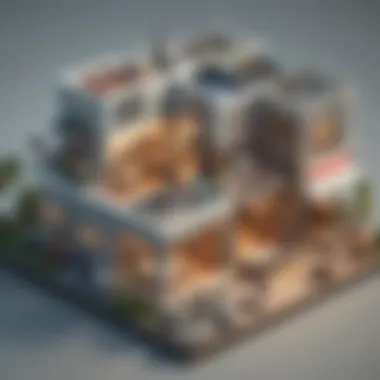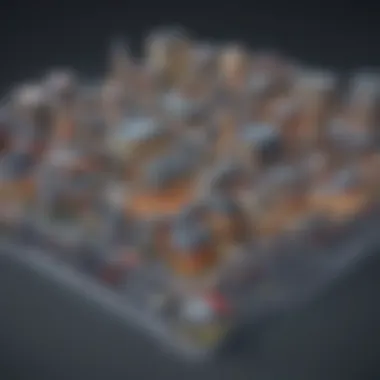Unveiling the Depths of 3D Modeling Through SketchUp's Lens


Software Overview
SketchUp is a versatile 3D modeling tool that holds immense potential for small to medium-sized businesses, entrepreneurs, and IT professionals alike. It offers a comprehensive introduction to the world of 3D design, empowering users to visualize and bring their creative ideas to life with ease. SketchUp boasts a plethora of key features and functionalities, such as precision modeling tools, a robust library of textures and materials, and a user-friendly interface that simplifies the design process. Despite its advanced capabilities, SketchUp remains accessible to all skill levels, with several pricing plans and subscription options available to cater to individual needs.
User Experience
Navigating through SketchUp is a seamless experience, thanks to its intuitive user interface and well-organized navigational elements. Users can effortlessly access essential tools and features, fostering a smooth design workflow. The learning curve for SketchUp is relatively gentle, allowing beginners to grasp the basics quickly while providing advanced functionalities for seasoned professionals. Additionally, SketchUp offers reliable customer support options, including detailed documentation, community forums, and responsive helplines, ensuring users receive timely assistance whenever needed.
Performance and Reliability
SketchUp excels in terms of performance, offering swift and efficient processing capabilities that enhance user productivity. Its uptime statistics are impressive, with minimal downtime reported, ensuring uninterrupted workflow for design projects. Moreover, SketchUp seamlessly integrates with various tools and plugins, amplifying its functionality and versatility in diverse design scenarios, making it a preferred choice for many professionals in the industry.
Security and Compliance
Data security is a top priority for SketchUp, as reflected in its robust data encryption protocols and secure cloud storage solutions. The software complies with industry regulations and standards, providing users with peace of mind regarding their sensitive information. In addition, SketchUp implements backup and disaster recovery measures to safeguard user data in cases of unforeseen events, further solidifying its reputation as a secure and reliable 3D modeling platform.
Introduction to SketchUp 3D Modeling
The introduction to SketchUp 3D Modeling sets the foundation for understanding the intricate world of 3D design. In this article, we delve into the core aspects, benefits, and considerations of SketchUp. SketchUp serves as a powerful tool for designers, architects, and artists to bring their ideas to life in a virtual environment. By exploring the fundamentals of SketchUp, readers will grasp the essential elements necessary to navigate the realm of 3D modeling with ease and proficiency.
Understanding the Basics of SketchUp
SketchUp Interface Overview
The SketchUp Interface forms the backbone of the software, providing users with a user-friendly and intuitive platform to create stunning 3D models. Its simplistic yet functional design allows for seamless navigation and manipulation of objects within the workspace. One of the key characteristics of the SketchUp Interface is its minimalist approach, which prioritizes functionality and accessibility. This design choice makes SketchUp a popular choice among beginners and professionals alike, enabling users to focus on their designs without unnecessary clutter. While the SketchUp Interface offers a straightforward user experience, some users may find its lack of advanced features limiting in complex projects.
Tools and Functions in SketchUp
The diverse array of tools and functions in SketchUp empowers users to unleash their creativity and bring their visions to life. From basic drawing tools to advanced modeling features, SketchUp offers a comprehensive toolkit to cater to various design requirements. The key characteristic of SketchUp's tools and functions is their versatility, allowing users to craft intricate designs with precision and efficiency. This wide range of functionalities makes SketchUp a beneficial choice for both novices and experts in the field of 3D modeling. However, the sheer number of tools available may overwhelm new users initially, requiring time to master each tool's functionality.
Navigating the Workspace


Navigating the workspace in SketchUp is essential for maintaining an organized and efficient workflow. The workspace layout in SketchUp is designed to enhance productivity and streamline the design process. Users can easily switch between different views, adjust settings, and customize their workspace to suit their preferences. The key characteristic of navigating the SketchUp workspace is its flexibility, allowing users to tailor the interface according to their workflow. This adaptability makes SketchUp a popular choice for users with diverse design needs. Despite its customizable nature, some users may find the initial setup of the workspace complex, needing time to familiarize themselves with the various customization options.
Installation and Setup Process
Downloading SketchUp Software
The process of downloading SketchUp software marks the initial step towards embarking on your 3D modeling journey. Downloading SketchUp software grants users access to a plethora of design tools and features essential for creating stunning 3D models. The key characteristic of downloading SketchUp software is its simplicity, enabling users to acquire the software effortlessly from the official website. This streamlined process makes SketchUp a popular choice for aspiring designers seeking a user-friendly platform. However, users with slower internet connections may experience delays in downloading the software, impacting their ability to dive into the world of SketchUp promptly.
Installation Steps for Different Platforms
The installation steps for various platforms play a crucial role in ensuring a seamless setup process for SketchUp. The detailed installation steps cater to users using different operating systems, providing a tailored experience for each platform. The key characteristic of installation steps for different platforms is their inclusivity, accommodating users regardless of their device or system preferences. This inclusive approach makes SketchUp an accessible option for users with diverse technological backgrounds. Nevertheless, users with limited tech knowledge may encounter challenges during the installation process, requiring external assistance to navigate through the platform-specific steps.
Configuration and Preferences
Configuring SketchUp software according to your preferences is paramount for optimizing your design workflow. The configuration and preference settings in SketchUp allow users to customize the software to align with their specific design requirements. The key characteristic of configuration and preferences is their adaptability, enabling users to tweak settings and options based on their workflow preferences. This customizable nature makes SketchUp a versatile tool suitable for a wide range of design projects. However, novice users may find the plethora of configuration options overwhelming, necessitating a learning curve to harness the full potential of SketchUp's customization abilities.
Getting Started with SketchUp
Creating Your First Sketch
Embarking on the journey of creating your first sketch in SketchUp marks a significant milestone in your 3D modeling venture. Creating your initial sketch allows you to familiarize yourself with the basic drawing tools and functionalities of SketchUp. The key characteristic of creating your first sketch is the hands-on experience it offers, giving users the opportunity to practice fundamental design techniques. This practical approach makes SketchUp an ideal choice for beginners looking to hone their design skills. Nonetheless, newcomers may face challenges initially in adapting to the software's interface and tools, requiring patience and practice to master the art of sketching in SketchUp.
Manipulating Objects
Manipulating objects within the SketchUp environment is essential for crafting intricate and detailed 3D models. The manipulation of objects encompasses actions such as moving, scaling, and rotating elements within your design. The key characteristic of manipulating objects is its precision, allowing users to control and adjust elements with accuracy. This level of precision makes SketchUp a preferred choice for users who require meticulous detailing in their designs. However, users accustomed to other design software may need time to acclimate to SketchUp's unique object manipulation methods, necessitating a learning period to grasp the intricacies of the software.
Applying Materials and Textures
Applying materials and textures to your 3D models in SketchUp adds depth and realism to your designs, enhancing their visual appeal. The process of applying materials involves selecting textures and colors to render surfaces within your model. The key characteristic of applying materials and textures is the visual enhancement it brings to your designs, elevating them from basic models to intricate visual compositions. This visual enhancement feature makes SketchUp a popular choice among designers seeking to create realistic and immersive 3D environments. Nevertheless, users new to texture application may find the process daunting initially, requiring experimentation and exploration to master the art of material application in SketchUp.
Advanced Techniques in SketchUp


Advanced Techniques in SketchUp play a pivotal role in expanding the horizons of 3D modeling capabilities. Delving into advanced techniques enables users to harness the full potential of SketchUp, elevating their design prowess. By mastering intricate tools and features, users can enhance the quality and complexity of their projects, ensuring a professional outcome.
Mastering SketchUp Tools
Utilizing Components and Groups
The utilization of components and groups within SketchUp is a fundamental aspect of creating intricate models efficiently. By organizing design elements into components and groups, users can easily manipulate and modify specific parts without affecting the entire structure. This feature simplifies the editing process, promoting productivity and precision in modeling. Components and groups also enable users to reuse elements across different projects, enhancing workflow consistency and saving time.
Working with Layers and Scenes
Working with layers and scenes in SketchUp enhances the visual representation and organization of 3D models. Layers help segregate different elements of the design for better management and editing control. By setting up scenes, users can create various viewpoints and configurations of the model, allowing for diverse presentations or simulations. This function is particularly beneficial for architectural visualization and project documentation, providing a systematic approach to design exploration.
Employing Plugins for Enhanced Functionality
Employing plugins introduces a wide range of functionalities and features beyond the native capabilities of SketchUp. Plugins can streamline complex tasks, introduce new tools for specialized needs, and enhance the overall modeling experience. By integrating plugins, users can customize their workflow, access advanced rendering options, and explore innovative design techniques effortlessly. However, while plugins expand the software's versatility, users must exercise caution in selecting reliable plugins to ensure stability and compatibility within their projects.
Application of SketchUp in Industries
3D modeling with SketchUp finds extensive application in various industries due to its versatile features and practical uses. Architects, interior designers, engineers, construction professionals, and product designers benefit significantly from SketchUp's capabilities. For architects and interior designers, SketchUp aids in creating intricate building layouts with precision and detail. Its intuitive tools make designing interior spaces a fluid process, allowing for optimal visualization and presentation. Visualizing renovation projects becomes seamless with SketchUp, providing a clear picture of the proposed changes.
In the realm of engineering and construction, SketchUp plays a vital role in structural modeling. Professionals leverage SketchUp to conceptualize and refine structural designs efficiently. Site planning and development benefit from SketchUp's ability to create accurate 3D representations of projects, aiding in decision-making and resource allocation. Collaborative project management becomes streamlined through SketchUp, enabling team members to collaborate effectively and synchronize efforts towards project completion.
Product designers and prototypers utilize SketchUp for concept visualization to bring ideas to life with detailed 3D models. Product iteration and testing are enhanced through SketchUp's flexible tools that allow for rapid modifications and adjustments. Integration with 3D printing technologies further enhances the prototyping process, facilitating the creation of physical models quickly and accurately.
Each industry sector highlighted demonstrates the profound impact SketchUp has on optimizing workflow and fostering creativity and innovation. By incorporating SketchUp into their practices, professionals across diverse fields can elevate their design processes, visualize concepts effectively, and streamline project execution for enhanced outcomes.
Optimizing Workflow with SketchUp
In the realm of 3D modeling, optimizing workflow with SketchUp emerges as a pivotal aspect that small to medium-sized businesses, entrepreneurs, and IT professionals need to embrace. Efficient workflow optimization ensures seamless project management and enhanced productivity, which are crucial in the competitive design industry. By focusing on specific elements like project organization, automation, and customization, users can streamline their processes and achieve optimal results. Understanding the relevance of optimizing workflow with SketchUp can significantly impact the efficiency and success of design projects.
Efficient Project Organization


File Management Practices
Delving into file management practices within SketchUp is essential for maintaining a structured and organized workflow. Effective file management allows for easy access to project files, version control, and collaboration across teams. The key characteristic of efficient file management lies in categorizing, naming, and storing files in a logical manner to facilitate quick retrieval when necessary. By adopting best practices in file management, users can avoid confusion, reduce errors, and improve overall project efficiency. While the advantage of meticulous file organization is evident, it is vital to acknowledge the time investment required for initial setup and maintenance.
Template and Style Utilization
Utilizing templates and styles in SketchUp contributes to creating a cohesive and professional design approach. Templates provide a foundation with predefined settings, including layers, styles, and components, streamlining the design process. The key characteristic of template and style utilization is the ability to maintain consistency in projects and save time by avoiding repetitive tasks. However, one must consider the balance between using templates for efficiency and customization for unique project requirements. The advantage of template and style utilization lies in standardizing workflows and promoting a cohesive design language throughout projects.
Collaboration Tools Integration
Integrating collaboration tools into SketchUp enables seamless communication and project coordination among team members. By utilizing features like live editing, comments, and sharing functions, users can work together in real-time, regardless of geographical locations. The key characteristic of collaboration tools integration is fostering a collaborative environment that promotes creativity and efficiency in design projects. While the benefits of real-time collaboration are significant, challenges such as data security and version control need to be adequately addressed to ensure smooth teamwork. The advantages of collaboration tools integration include improved communication, accelerated decision-making, and enhanced project transparency.
Workflow Automation and Customization
Creating Templates and Plugins
The creation and usage of templates and plugins within SketchUp automate repetitive tasks and enhance design efficiency. By developing custom templates and integrating plugins tailored to specific project requirements, users can simplify complex processes and accelerate workflow. The key characteristic of creating templates and plugins is the ability to personalize SketchUp's functionality to suit individual preferences and project needs. However, users must be cautious of compatibility issues and potential conflicts when using third-party plugins. The advantage of creating templates and plugins lies in boosting productivity and optimizing workflow through tailored solutions.
Streamlining Repetitive Tasks
Streamlining repetitive tasks in SketchUp involves identifying frequent actions and implementing shortcuts or scripts to expedite processes. By automating repetitive tasks like creating standard components or generating reports, users can save time and focus on the creative aspects of their projects. The key characteristic of streamlining repetitive tasks is the reduction of manual labor and the potential for error, leading to increased efficiency and accuracy. Nonetheless, users should exercise caution when relying heavily on automation, as it may limit creativity and problem-solving in certain scenarios. The advantage of streamlining repetitive tasks is evident in time savings, reduced monotony, and improved workflow consistency.
Enhancing Productivity with Shortcuts
Enhancing productivity in SketchUp through the use of shortcuts optimizes the user experience and accelerates design processes. By familiarizing oneself with keyboard shortcuts, menu customization, and tool presets, users can navigate SketchUp more efficiently and perform actions swiftly. The key characteristic of enhancing productivity with shortcuts is the accessibility to specific tools and functions without extensive manual navigation, enhancing workflow speed and agility. However, users should be mindful of the learning curve associated with mastering shortcuts and ensure a balance between efficiency and reliance on shortcuts. The advantage of enhancing productivity with shortcuts lies in improving user proficiency, reducing task completion times, and maximizing overall productivity.
Best Practices for Rendering and Presentation
Choosing Rendering Engines
The selection of rendering engines in SketchUp plays a critical role in achieving visually appealing and photorealistic outcomes for design projects. By evaluating factors like rendering speed, output quality, and compatibility with SketchUp, users can choose an engine that aligns with their rendering needs. The key characteristic of choosing rendering engines is the balance between performance and output aesthetics to enhance project presentation. Nevertheless, users should consider the hardware requirements and licensing costs associated with specific rendering engines to optimize rendering efficiency. The advantage of choosing rendering engines includes improved visual quality, faster rendering times, and customizable rendering settings.
Creating Realistic Visualizations
Creating realistic visualizations in SketchUp involves utilizing lighting, textures, and materials to enhance the overall realism of design presentations. By incorporating advanced rendering techniques and realistic elements, users can develop immersive and detailed visualizations that showcase their design concepts effectively. The key characteristic of creating realistic visualizations is attention to detail, balance in lighting and textures, and seamless integration of design components to emulate real-world scenarios. While the advantage of realistic visualizations is evident in improving client engagement and project visualization, users should be mindful of the potential complexities and time-intensive nature of producing high-fidelity renderings.
Presenting Designs Effectively
Presenting designs effectively in SketchUp requires a strategic approach that combines storytelling, visual aids, and interactive elements to engage stakeholders. By utilizing features like scene transitions, annotations, and virtual tours, users can create compelling presentations that communicate design intent efficiently. The key characteristic of presenting designs effectively is the ability to convey complex ideas in a clear and visually appealing manner that resonates with the audience. However, users should ensure that presentations are tailored to the target audience's preferences and level of technical understanding to maximize impact. The advantage of presenting designs effectively lies in enhancing communication, fostering client trust, and ultimately facilitating decision-making in design projects.







